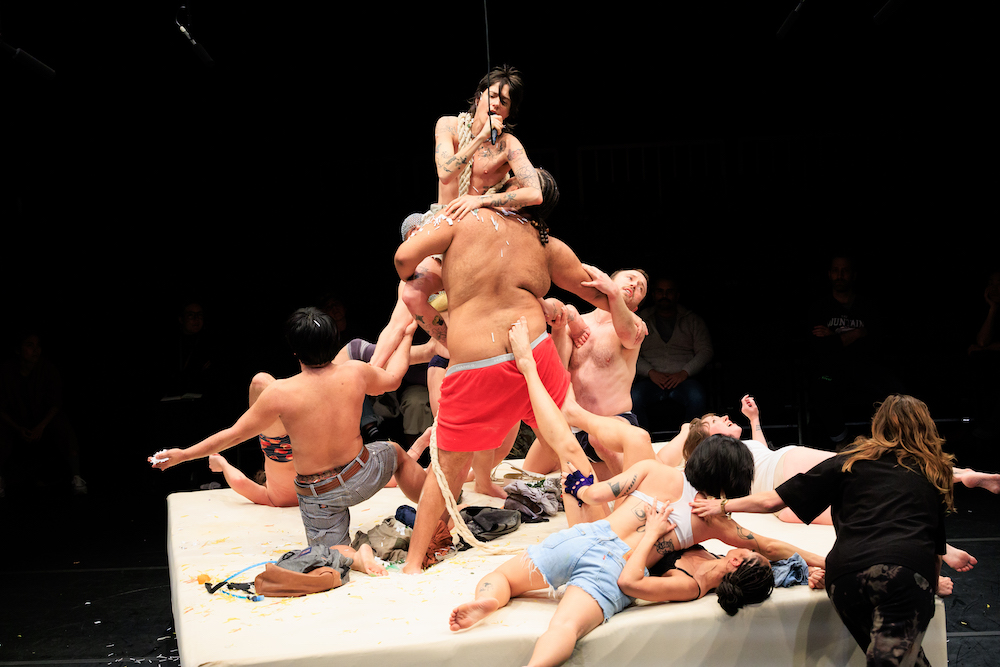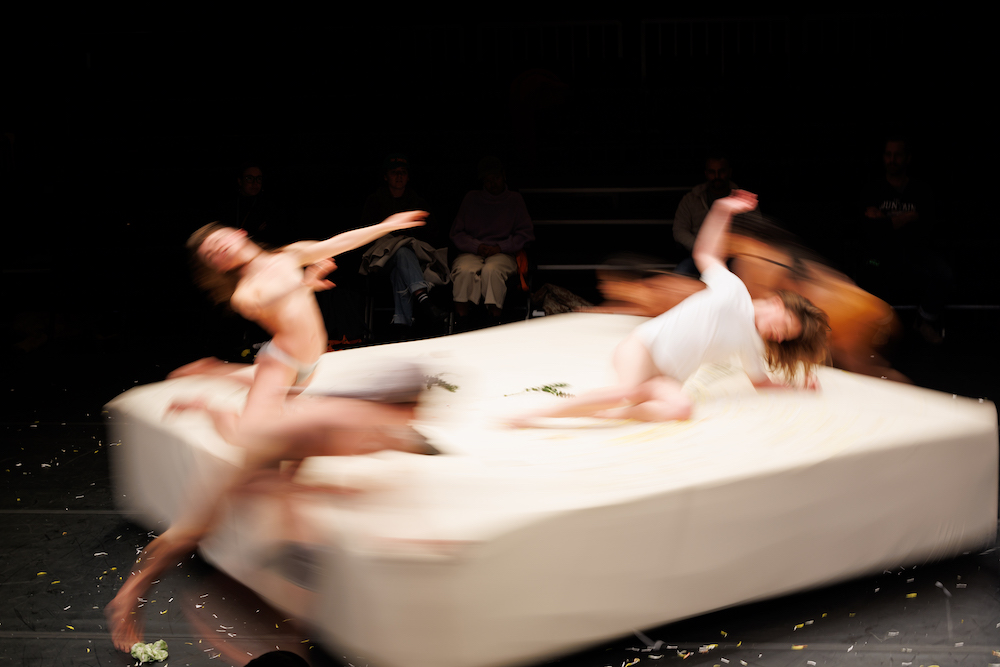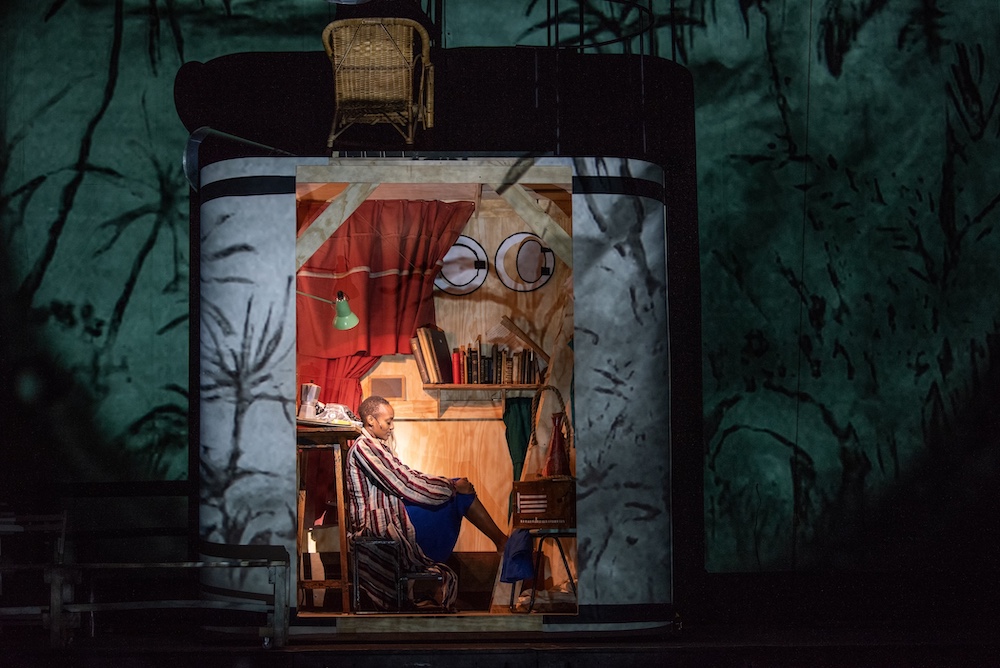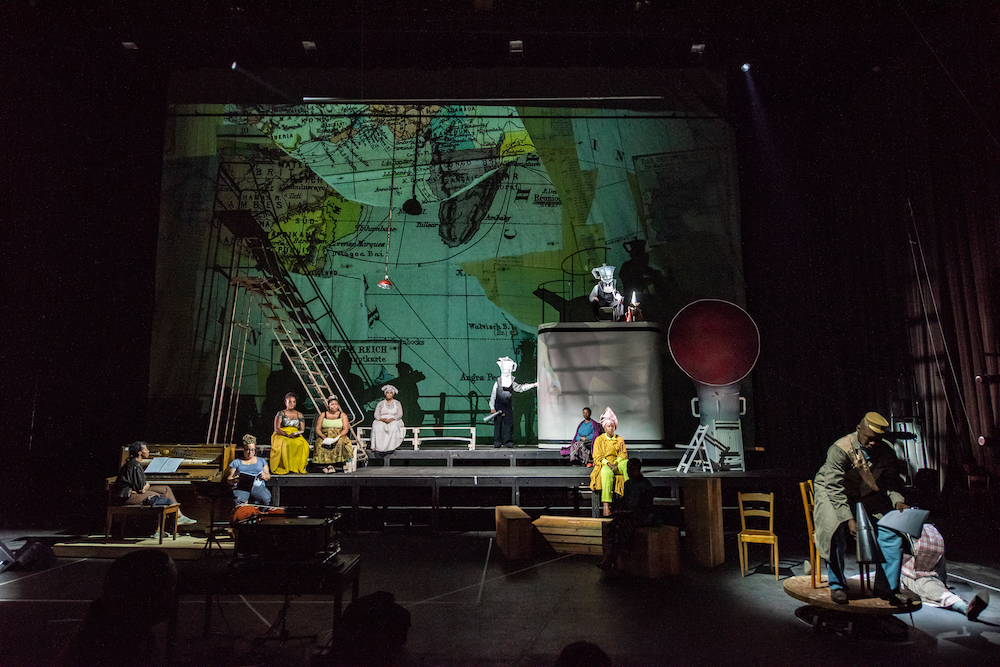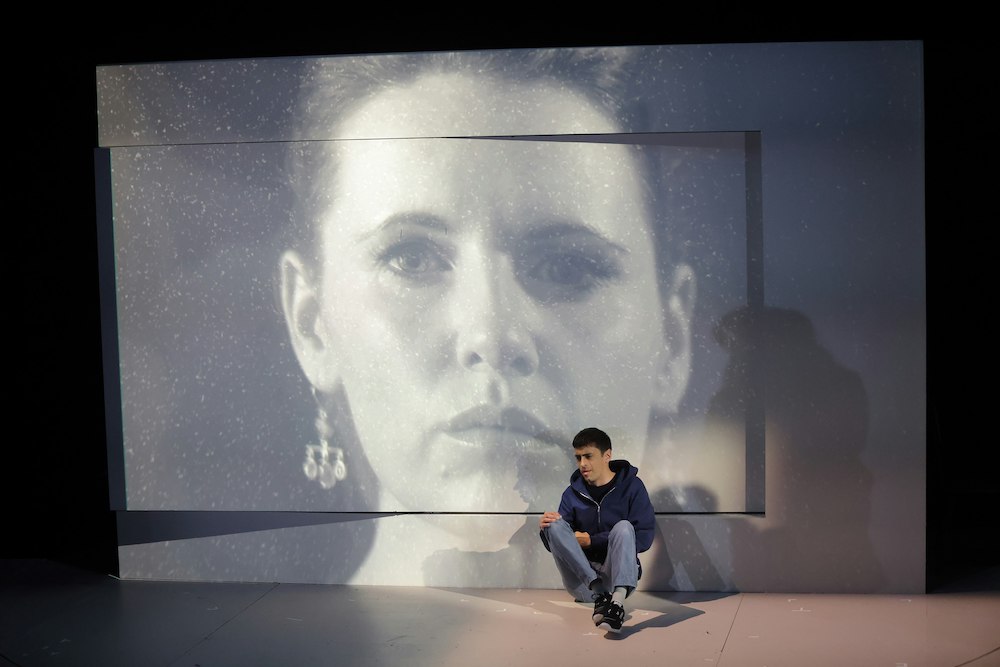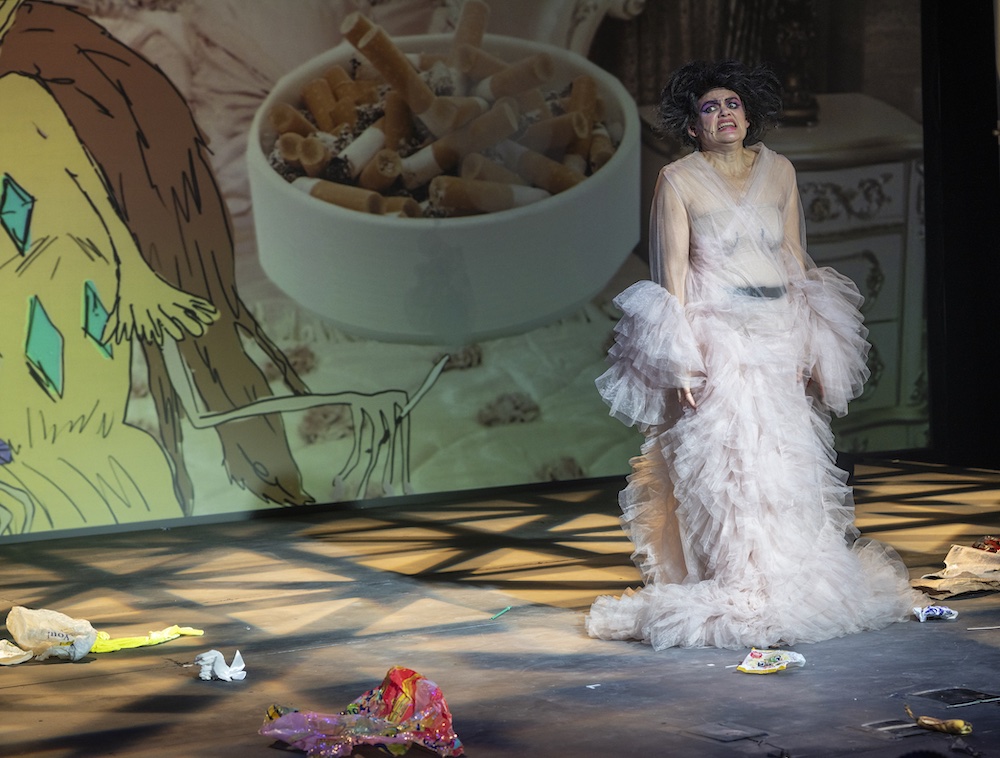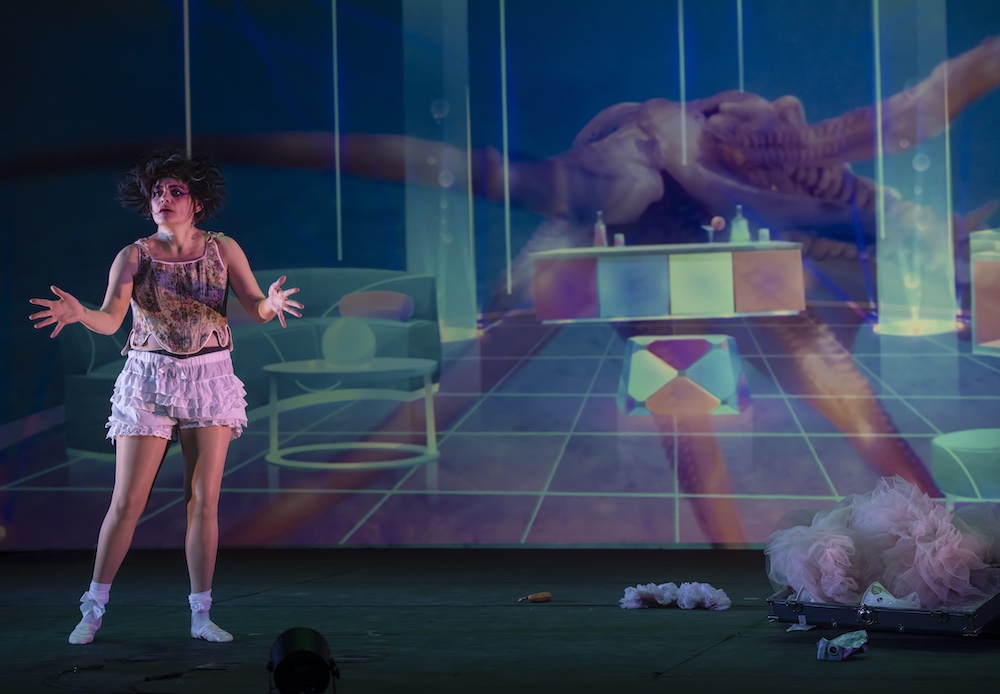Your cart is currently empty!
Tag: performance review
-

FAYE DRISCOLL
at REDCATI’ve always said that I have a crush on dance—on the medium itself, its libidinousness, its structural uninhibitedness, the insanity of memorizing your body’s movements on command and then repeating them. As a writer, I cling to permanence on the page, but dance offers none. “Weathering,” choreographed by Faye Driscoll, and performed at the RedCat Theatre on February 6–8, leans into the artform’s inherent ephemerality: 10 dancers writhe, collapse and spill over one another on a mattress-like raft, forming a shifting, interdependent mass. The audience is seated in the round, while dancers rotate their raft-stage so that viewers are granted a complete view of the scene. The result is that the dancers’ movements feel visually lapsed: we barely catch it when they shift.
I went into the performance knowing it was inspired by climate collapse and catastrophe, but I was interested in how it would feel to see it in Los Angeles—a city mid-crisis, mid-collapse—where the air still carries the residue of wildfire and disaster has become the season we live in. Dance, with its impermanence, feels like the appropriate medium for disaster. Driscoll is known for attuning her performances to place and circumstance—was there always a dancer with a JanSport backpack eerily reminiscent of a go-bag? Do audience members always guffaw this much?

Faye Driscolls “Weathering” at REDCAT. Photo: Angel Origgi. Courtesy of REDCAT Roy and Edna Disney CalArts Theater. The performance begins as the dancers walk around the central stage in a flurry chanting operatically: Oh Spit, Oh Cum, Oh, Fascia. Outfitted in muted, mixed-climate attire that feels uniquely appropriate to Los Angeles (denim cut-offs, a puffer vest), they carry bags that will eventually spill out in a cacophony of capitalistic detritus: mascara, headphones, wallet, iPhone. Joining each other on the mattress, they enter a state of hyper-presence, with movements so micro-attuned that it feels as if nothing happens for a very long time.
After some time, stagehands emerge, spinning the raft slightly, and over the course of the next hour, the whole show goes pretty wild—clothes are peeled away, spit drips out of mouths onto other bodies, limbs are tangled indistinguishably; there is fruit and flowers and soil, the raft continuously accelerates, and the audience is anointed with an earthy, scented mist. The performance is also accompanied by a combination of live and recorded audio of dense breathing, humming and yelling. Seated in the front row like a kind of omniscient weatherman, Driscoll susurrates into her microphone, occasionally spinning the raft herself or wiping away sweat from the dancers.
“Weathering” demands a very generous and reciprocal presence from the viewer. There is something obscene about watching bodies work this hard. The dancers strain and sink into one another, their movements pulling urgency, exhaustion and sudden bursts of life. They move both as a unit and as individuals, attuned to each other in ways that feel both practiced and spontaneous. Their movements make me think about the choreography of effort, of removing debris after a flood or digging through ash after a fire. “Weathering” might also refer to the slow erosion of the body, the long-term effects of crisis that settle in the bones. The performance is described in promotional materials as a “multi-sensory flesh sculpture surging through the Anthropocene,” but it feels less like a sculpture than an ecosystem, an unstable and interdependent structure always threatening to collapse. Many of the poses appear drawn directly from elements of Romantic painting, particularly Théodore Géricault’s The Raft of the Medusa, with bodies draped over one another in precarious arrangements, their limbs reaching outward in gestures of desperation and survival.
We want to believe we can control the weather. We study it, predict it, try to shape the future in its image. But “Weathering” does something else—it exposes the mechanics of a system we are inside, whether we want to be or not. It hums with a hunger for divinity, for something beyond survival. The bodies press and yield, shaping and reshaping each other in real time. As climate change renders our city a godless inferno, this work feels like a kind of prayer. When I leave, I think about how our bodies are designed to protect us from toxins—how the nose and throat tickle to warn us, how mucus is productive. The body responds before the mind catches up. “Weathering” offers a commitment to moving through catastrophe together, body to body, breath to breath.
-

WILLIAM KENTRIDGE
at The WallisIn his monumental displays of structure, history, movement and sound—operatic compositions that unabashedly aspire to the now-“traditional” status of Gesamtkunstwerk, William Kentridge has become a leading voice not only in contemporary art but in the world’s cultural and social discourse. At this point, after decades of engagement with the immoralities of apartheid in his native South Africa, Kentridge doesn’t so much speak on behalf of his Black countrymen—a necessarily awkward advocacy—as speak about and, in works like “The Great Yes, The Great No,” around the legacy left to a country like South Africa by a fraught modern history.
The quasi-opera concerns itself with a moment where Europe’s artists and intellectuals, having exoticized their subjugated African counterparts, had reason (need, really) to move closer to the civilization that so infatuated them. In this instance, that civilization was found not in Africa, but from Africa, in the Caribbean. In 1941, André Breton fled France’s Vichy regime by sailing to Martinique, where his Surrealist movement was already providing a theoretical basis for anti-colonialist sentiment. Also on board were Aimé Césaire and his wife Suzanne, African citizens of France who were crucially involved in the Surrealist/Black nationalist movement négritude (which would later play a role in the liberations of France’s sub-Saharan colonies).
Such an admixture of politics, aesthetics, history and drama appeals deeply to Kentridge, who allows himself some factual liberty to drive home his modernist fantasy (such as placing Cuban Surrealist painter Wifredo Lam and post-colonialist theorist Frantz Fanon aboard ship). The whole incident becomes bigger than itself in Kentridge’s hands, a pretense that might irk some scholars but which in fact marks the multimedia production not as an historical pageant but as an (art-)historical vision.

William Kentridge, “The Great Yes, The Great No,” 2025, at The Wallis. Courtesy of The Wallis. The chorus-like staging, replete with masks, moves and stage meanders, does maintain a pageant quality. The music is choral, accompanied by a four-instrument band. From their appearance, accents, and choreographies (individual and group), the actor-singers are apparently South African. For Kentridge these are not performers engaged in exotic ritual, but his neighbors and sometimes fellow strugglers. Aimé Césaire, Wifredo Lam—genuine Surrealists outside Europe—are figures from recent history who clearly inspire the artist’s awe. As he unapologetically demonstrated in his retrospective at the Broad last year, Kentridge is a Modernist fanboy par excellence.
The set for “The Great Yes, The Great No,” mostly chairs and benches downstage, is backed by an expansive diagrammatic rendition of a ship’s deck, actually taken from that of a South African ferry (if I understood correctly), above which pinwheel myriad different images and, often, slogans appearing in response to dialog on stage. The chorus-like ensemble moves fluidly before this droll firmament; their fractured processionals, along with the maze-like backdrop, recall the manically bisected performance spaces of another neo-Modernist impresario, the late Richard Foreman. Foreman was himself more of a Surrealist than Kentridge, but their passions are shared, as they also embrace Bauhaus theater and dance, stage-work of the Russian Avant Garde, Dada provocation, and of course the manifold pretenses of opera, grand and especially chamber. William Kentridge has many boxes and thinks outside all of them.
-

ADORATION
at REDCAT
Atom Egoyan’s 2008 film Adoration follows a half-Arab teenager who weaves a fictional story about his father orchestrating a terrorist attack, causing a stir within his suburban community. Adapting it would be a difficult task in any case—not just because of the weighty subject matter, but because the plot is rather convoluted, involving a meddling drama teacher with her own secret history. Alas, REDCAT’s spin on the film, a live theatrical performance presented in collaboration with the LA Opera and cosigned by Egoyan (but developed without his assistance), has only made it harder to follow along with the drama—or delve into the characters’ motives. Segments of the teen’s classmates video-chatting about his claims appear more contrived and less naturalistic in the theater than they do onscreen. The moments that did move me stood out not so much as interpretations of the source material but as gestures toward the themes of voyeurism and performance that preoccupy Egoyan’s rich filmography as a whole: during flashback scenes, Simon lingers on the verge of his parents’ interactions, occasionally nudging them into place as if to direct them; memories are often described through a secondary party’s perspective (“I watched you watching her”). -

Postmodern Vaudeville
Amy Gerstler on Dynasty Handbag’s Frenzied Satire Titanic Depression at MOCAEven though the term ‘performance art’ has become a catch-all phrase, it still feels too narrow to convey the onstage antics of Dynasty Handbag, the performance persona of writer, visual artist and actor Jibz Cameron. When Titanic Depression debuted in New York in 2023, its sensibility was described by the New York Times as “queer vaudevillian.” That’s a more intriguing, and perhaps more accurate label. In November 2024, MOCA hosted three nights of Titanic Depression, Cameron’s multi-media live show, starring her alter ego Ms. Handbag. This show, lightly updated since its premiere, is a blockbuster solo performance: a zany, affecting dreamscape, hybridizing theatre, animation, cabaret, video, political critique and clowning.
Cameron’s work as Dynasty Handbag is sui generis with a vengeance. This is true of her stand-up comedy performances like The Bored Identity (now available on vinyl!) and of Dynasty’s turns as the trash-clad, gyrating curator/MC of her long-running underground variety show “Weirdo Night.” Cameron, a long time Angeleno, is a Guggenheim fellow, and her visual work was included in the Hammer Museum’s Biennial exhibition “Made in LA” in 2023.
In Titanic Depression Dynasty Handbag embarks on a classic heroine’s journey. She confronts climate disaster, battles family repression, and has a sexual dalliance with an octopus, complete with an exhaustive, hand-penned, pre-coital consent form. She stumbles into a roomful of male cigar-puffing, planet-wrecking billionaire capitalist bastards from various eras, which provides a quick history lesson for the audience. And she suffers a searing bout of existential panic which she tries, for the most part unsuccessfully, to escape with the aid of meditation apps. The iceberg threatening to destroy her luxury cruise ship melts (thank you, global warming) but is replaced by an aggressive island of ocean trash, which may pose a greater threat. One of the loose through-lines in this wacky tale is the narrative’s ingestion and subsequent subversion of a few plot points from James Cameron’s 1997 film Titanic. (About the shared Cameron surname: The fact-checkers at Artillery are pretty sure Jibz and James aren’t related, but anyone with information otherwise is welcome to contact us… )

Dynasty Handbag, “Titanic Depression.” Performance documentation from The Geffen Contemporary at MOCA. Image by Elon Schoenholz courtesy of MOCA. Performer: Jibz Cameron. Cameron is a natural actor, mistress of a smorgasbord of cartoon voices that would make Mel Blanc proud. She’s got the manic, rubbery physical comedy thing down cold. She’s a skilled enough dancer that when she chooses to flail and dance ‘badly,’ you remain mesmerized. Her signature makeup for the Dynasty character brings to mind a demented mime, Charlie Chaplin’s Little Tramp and/or Faye Dunaway’s Mommy Dearest visage mid-facial. Thus constructed, Dynasty’s face harkens back slightly to silent films. Topped by a spiky black wig, that face is as elastic as bread dough and gymnastically expressive. Her costumes feature garbage bags and thrift store regalia. Her pantyhose, webbed with runs, often serve as stand-alone ragged pants (ooh la la!) worn beneath a short jacket. At one point she sports a flesh-colored unitard with cartoon breasts and squiggly pubic hair felt-penned over the appropriate zones. The overall effect of her costumes, which tend to slip or fall off, is a mix of little kid dress-up, madwoman, and lesbian burlesque. She has a way of sending up tropes of conventional sexiness and exploding them.
In terms of props, repurposed trash litters the stage by the end of the performance. Items from what might be a recycling bin or treasure chest, jumbled up with junk from grandma’s attic get pulled out on cue when Dynasty is frantically searching for something to push the narrative forward or to get out of a jam. An overripe banana, her only live co-star, doubles as cellphone and as microphone for a crooned musical number or two. There’s a moment when Cameron sings a song she wrote to the tune of “When a Man Loves a Woman.” Her take-off on that song, “When a Man has an Idea,” is a comic lament about mansplaining and its dominating damage, inescapably wreaked on, well, everyone.
The backdrop for Titanic Depression is Dynasty’s most important co-star. The video by collaborator Mariah Garnett plays on a screen that spans the stage’s entire back wall. Animated video runs before the show even begins and continues throughout the performance. The video provides various settings, some aboard ship, some underwater, plus doctored clips from an array of films about the Titanic, as well as other archival material. Wonderfully misspelled text exchanges between Dynasty and her never-seen therapist appear, typed out in real-time, courtesy of the video. Additional characters, fully animated or topped by Cameron’s actual videoed head gabbing away on caricatured bodies appear onscreen and interact with the live Dynasty. This means, for example, that while Cameron plays Dynasty onstage, on the video backdrop she’s playing Dynasty’s screechy, smothering mother, leading to a series of altercations with herself. The video backdrop is funny, eye-popping, and an essential, unifying contribution to Titanic Depression’s pace and look.

Dynasty Handbag, “Titanic Depression.” Performance documentation from The Geffen Contemporary at MOCA. Image by Elon Schoenholz courtesy of MOCA. Performer: Jibz Cameron. How is it that although this performance brandishes its seams, that only makes the work more intimate and effective? By “brandishes its seams,” I mean that Cameron regularly breaks character and addresses the audience using what one could call her “normal voice” and persona. There are glitches in the performance (usually trouble changing a costume, or a forgotten line) that seem intentionally inserted or at least expected, and embraced when they occur. These scattered moments provide Cameron a chance to stand outside the piece and make observations that a character conventionally enmeshed in the action could not. Rather than this feeling like a mistake, it worked for this viewer as a form of layering and another kind of through-line. We get both Cameron’s and Dynasty’s perspectives overlaid intermittently, situated inside and outside the plot, via this device. Sometimes we’re even privy to tidbits about the construction and genesis of the piece. In other words, this is not a work of art intent on maintaining airtight illusions or preserving the so-called theatrical “third wall.” Instead, Cameron seems determined to periodically puncture the fiction she’s been constructing, so she can rebuild it again and again.
Cameron is great at creating a sense of the eternal now. Watching her work, one has the feeling that what she’s doing and saying on stage is being born in that instant, exploding from her mind as you’re seeing it, fresh and current, though it’s simultaneously clear that Titanic Depression is NOT mostly extemporized, but developed and rehearsed, complete with its audio, lighting, elaborate video interface, etc. When Titanic Depression makes a point to lean into its DIY improv aesthetic, appearing to embrace the spontaneous rather than having been rehearsed into rigidity, a creative, playful relationship to chaos emerges. We’re sucked into the vortex of Cameron’s rampant, humane imagination and indignation. We get the message that if we’re going to survive the coming decades, we had better be ready to pivot at a moment’s notice. We had better get incredibly flexible and learn to be light on our feet. We’d better stay nimble and open.
I don’t know who Cameron considers her artistic influences to be, but it’s fun to speculate. There are bits of Lily Tomlin in what she does as monologist and repository of a panoply of characters. I wondered if Edward Albee’s sense of absurdity might have tinted her vibe. The barbed
comedy of Richard Pryor came to mind as I watched Titanic Depression, as well as Jonathan Winters’ prodigious wizardry with simple props. (For example, there’s a moment late in the show when Dynasty picks up the drinking straw from a Starbucks cup and uses it as a flute).Given the scary political drift of late, the Statue of Liberty might need a friend right about now. Perhaps Lady Liberty could use a second “…mighty woman with a torch…” to stand by her side for moral support, reinforcing her battered message. If anyone’s taking nominations, I’ll cast my vote for a 22-story, harbor-presiding likeness of Dynasty Handbag. Her blazing torch of gonzo comedy and razor-sharp satire casts a galvanizing light.
-

The Horse: A Performance by Chris Emile
Presented by Los Angeles Nomadic DivisionAt the wall in the back of the space rests an altar surrounded by oyster shells, pearls, pumpkin seeds, white candles on white cloth, white gloves, a brown fedora, a box of pralines, a Precious Moments angel. An audience member approaches and places a stem of white tuberose beside a bottle of Kahlua and the candles that flicker in the first cool September night. The wall behind is adorned with family photos, newspaper clippings, holy images and a photo of James Baldwin. Even before the performance begins, the archive and the altar have transported the audience into the sacred realm of The Horse by choreographer and dancer Chris Emile.
The 45-minute performance is presented by LAND (Los Angeles Nomadic Division) and features Emile in collaboration with sound architect Cody Perkins, vocalist Alevonallure, and West African drummers guided by Vodun practitioners. The show’s title refers to the Vodoun concept that the body is the “horse” that the inhabiting deity “rides.” The piece references ancestral knowledge and grief. Ancestors known, loved and gone, but still carried in the body. The spirituality of Vodun carried on by the Black diaspora; how tradition and ritual can be summoned for healing, how performed ritual brings catharsis for the observer too.
A circle of sod lit by a purple spotlight comprises the performance area. The piece begins with the sound of water. A trio of drummers and vocalist shrouded in white veils step onto the performance area followed by Emile veiled and clothed in roughly tied on white fabric reminiscent of a rag doll or a religious pilgrim. The dance begins subtly; Emile shuffles, turns slowly in the space, dragging his feet. At times Emile interacts with the vocalist, seemingly affected–or, perhaps, bothered–by their voice. There’s a feeling of being in purgatory and Emile is a lost soul or shade.
As the performance continues the trancelike music deepens and whips up, along with the drummers and the haunted keening from the vocalist. A transcendent fusion of sound, beat, voice, noise, movement, light and shadow. Emile falls to the earth, rubs in the dirt. He contorts, covers his mouth, falls back. His tongue escapes the veil. We are witness to possession.
Dancing against the image adorned wall, Emile’s embodies the ecstasy of St. Teresa–an erotic connection to Spirit. It is as though there is something behind the wall Emile is speaking to, trying to reach. Another veil, another realm that in the trance as dancer he is trying to connect with.
An interdisciplinary artist, Emile has a substantial background in dance, film, performance art and installation. The Horse draws attention to this as, at times, Emile breaks out of the trance-like movements into a familiar jazzy refrain and gestures more recognizable as “dance.” The climax seems to be Emile grappling with tension. The accompanying sound grows into a frenzy as does Emile. His movements are dynamic; releasing, falling, angrily gesturing, exploding into movement in that liminal space between technique and possession. Is the movement still a ballonné when he’s speaking to the dead?
The performance ends with Perkins sampling the gospel song performed by Tramaine Hawkins “Going Up Yonder.” Emile, after the climax, gratefully collapses onto the dirt. Alevonallure picks up from the recording and ends a cappella with the refrain “I’m going up yonder to be with my lord,” until that breaks apart too, and it’s just the echo of her voice, the purple light, and the exhausted body.
